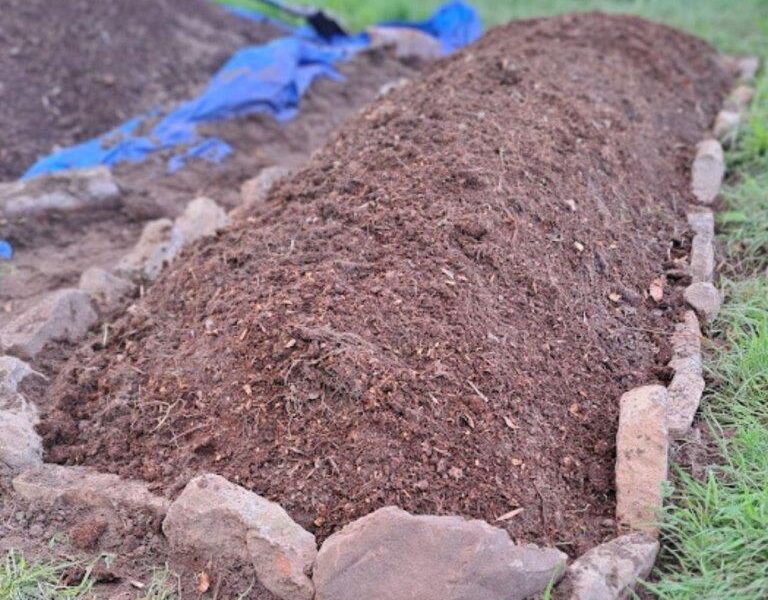Hügelkultur for soil improvement and green waste management
By Dan Austin
Translating to ‘hill culture’, hügelkultur is an old German and Eastern European method of creating raised beds consisting of woody material buried beneath layers of biomass, compost, and soil in a mound shape. In addition to the benefits of pest suppression and improved drainage that are gained through any raised bed, the woody biomass in the centre of a hügelkultur bed, gradually decomposes, building soil, retaining water and slowly releasing nutrients over time. The system generally requires less maintenance and less compost than traditional vegetable production and is a great way to deal with unwanted woody material while sequestering carbon in the soil.
The layering process involves first creating a long row of large branches and logs. These will make up about forty percent of the finished mound. A further layer of twenty percent is made up of smaller twigs and sticks. When building a hügelkultur bed, you should not use species that are allelopathic like black walnut (Juglans nigra), resist decay like cedars (Cedrus spp.), trees that sprout easily from prunings such as willows (Salix spp.) or any treated timbers.
When creating a hügelkultur bed, trees like firs (Abies spp.) and pines (Pinus spp.) that can leach tannins into the soil and cause it to become acidic, should also be avoided. The best woods to use include apple (Malus domestica), maple (Acer spp.), oak (Quercus spp.), poplar (Populus spp.), and wattle (Acacia spp.).

(Image: https://commons.wikimedia.org/wiki/File:Huegelbeet-by-Maseltov.jpg)
A third layer of finer plant waste including lawn clippings, leaves, and kitchen scraps, accounts for about twenty-five percent of the finished mound. With all the carbon being added to a hügelkultur bed, seasoned gardeners may be worried about a phenomenon known as nitrogen drawdown occurring during the decomposition process.
There are various microorganisms that aid in the decomposition of organic matter in soil and deplete nitrogen during the process; this is known as nitrogen drawdown and can lead to nitrogen deficiencies in plants. Bacteria, in particular, require a lot of nitrogen to aid in the breakdown of cellulose and hemicellulose.
Gardeners are often warned to avoid mixing woodchips or sawdust into soil to avoid the nitrogen drawdown that the decomposition of these products can induce. However, the logs within a hügelkultur bed have much less surface area exposed to bacteria than sawdust or woodchips and tend to encourage fungal decomposers rather than bacterial ones.
These fungi are much more efficient with their use of nitrogen and as a result, nitrogen drawdown is less of an issue. Nitrogen drawdown can also be mitigated with the last two layers of the beds, these being around ten percent of the finished bed being compost and topped with a five percent layer of healthy topsoil.

(Image: https://permakultur.files.wordpress.com/2020/10/permakultur-huegelbeet-aufbau.jpg)
Beds can be planted with various annual vegetables but the idea of hügelkultur is to slowly build soil over time, and as such the bed will eventually collapse. So, these beds are generally not suited to perennial plants that might be negatively impacted as the beds break down.
In addition to building soil health over time, hügelkultur beds are a great way to manage the flow of water on slopes and in high rainfall or flood-prone areas and can be used as part of swales and berms or to utilise the water they direct.
For all their merit these beds have at least one flaw; the large surface area of disturbed soil created, is an excellent place for opportunistic weeds to germinate, and if they get big, weeds can cause damage to the bed when being pulled because of the shallow soil profile. So, a thick layer of mulch or cardboard layering is a recommended finishing tip.
So, there you have it – hügelkultur. It is production requiring less ongoing work and water, improves soil, sequesters carbon, and even makes things easier on your back, so do yourself a favour and give hügelkultur a chance in your garden or a garden design.
Dan Austin
Author, Lecturer,
TAFE South Australia
M: 049 122 8591
E: daniel.austin@outlook.com

